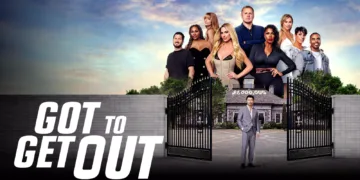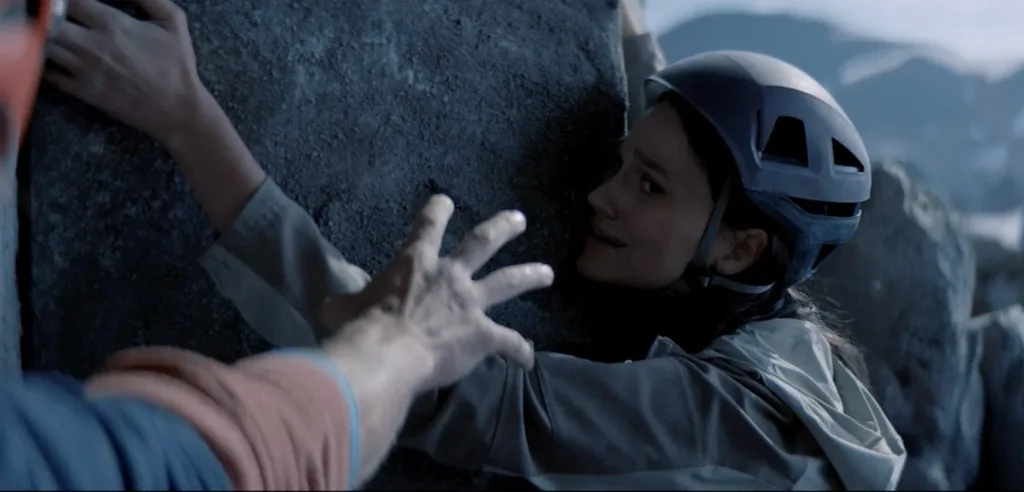The idea is potent: a supernatural horror story staged on the vertical face of a mountain. The Sound invites us to the Forbidden Wall, a formidable peak on tribal land, shrouded in a dark history since a climbing expedition vanished there 63 years ago. This clash between modern recreational ambition and ancient, sacred ground forms the film’s central tension.
A new team, a collection of elite climbers, has been granted access to this place that was never meant for them. Among them is Sean, a man whose grandfather was part of the original doomed party. He climbs not just for sport, but to confront a piece of his family’s tragic past. But the mountain is not an inert stage for human drama.
It is not empty. The climbers quickly find themselves in a battle against gravity, against the cold, and against an unseen presence that lives in the rock and whispers in the wind. Their expedition becomes a desperate struggle for survival against a force that wants them gone.
A Vertical World without Vertigo
A film set on a cliffside possesses an innate source of tension. The simple physics of the location—hundreds of feet of empty air, life reliant on a knot in a rope—should be a powerful cinematic tool for generating primal fear. Think of the way films like A Lonely Place to Die leverage the rugged, beautiful isolation of the Scottish Highlands to amplify a cat-and-mouse thriller.
The landscape becomes a character, its beauty and its danger shaping the narrative. The Sound, by contrast, stages its drama in this arena and manages to strip it of its terror. The camera remains stubbornly close to the actors, framing them in tight, static shots that deny any sense of their precarious position in the vastness of nature.
Without the wide, establishing views that would communicate the terrifying scale of the Forbidden Wall, the audience never feels the dizzying height or the profound isolation of the climbers. The danger becomes an abstract concept told to us, not a visceral experience felt in the pit of the stomach.
In key moments of peril, the action is lost in a murky darkness, a cinematographic choice that frustrates by obscuring the action instead of heightening fear through suggestion. This visual language fails to create synergy with the narrative’s high stakes. The result is a missed opportunity, a thrilling vertical stage presented with a stubbornly horizontal perspective that leaves the viewer disappointingly grounded.
A Script Weighed Down by Exposition
The film’s screenplay is its heaviest piece of equipment, slowing the ascent with its sheer, ponderous weight. The narrative advances not through visual storytelling or emergent action but through conversation, as characters constantly stop to explain the plot to one another. We are told about Sean’s guilt over a past climbing accident. We are told about the mountain’s dark history. We are told about the plan.
This reliance on exposition is a critical flaw, turning what should be a tense survival story into a series of static briefings that stifle momentum. The characters themselves are thin sketches, their personalities and motivations relayed through flat dialogue instead of being demonstrated through their choices under pressure.
Sean’s personal quest feels like a narrative requirement, not a deeply held need. The story is further cluttered by a clumsy and underdeveloped subplot involving government agents, a narrative thread that feels imported from a different, more generic thriller. It adds confusion without raising the stakes. Most disappointingly is the film’s treatment of the region’s Indigenous folklore.
The local tribal chief is presented as a stereotype out of central casting: the “wise elder” who speaks in riddles and exists solely to provide cryptic warnings to the white protagonist. This approach flattens a complex belief system into a simple plot device, a clear example of a Western narrative structure failing to meaningfully engage with the culture it borrows from.
Spiders on the Wall
There are moments when the film finds its footing and delivers genuine unease. When the mountain’s entity takes hold of a climber, the human form contorts in defiance of physics. People crawl up the sheer rock face with an unsettling, insect-like motion. This is effective body horror, a visual that connects to a tradition seen in Japanese horror where unnatural movement signifies a terrifying loss of humanity.
These scenes are genuinely chilling, brief glimpses of a much better film where the terror is physical and primal. These flashes of inspiration are, however, too few and far between to build sustained dread. The threat quickly becomes repetitive, its power diminishing with each predictable appearance. The film’s tone wobbles, with certain intended scares veering into silliness, such as a possessed man inexplicably biting through a heavy-duty climbing rope or a strange, phantom wrestling match near the summit.
A film titled The Sound also seems curiously uninterested in its own auditory potential. The disembodied voices and strange noises provide some basic atmosphere, but it lacks the innovative soundscape needed to create an invasive, psychological horror experience. The film contains the right terrifying ingredients, but it fails to combine them into a consistently frightening whole.
“The Sound” is a horror thriller film that was released in theaters and on Video on Demand (VOD) platforms on June 27, 2025. The film is available to watch on major VOD platforms, including Apple TV, Amazon Prime Video, and Fandango At Home.
Full Credits
Director: Brendan Devane
Writers: Brendan Devane
Producers: Brendan Devane
Executive Producers: James Devane
Cast: Marc Hills, Rachel Finninger, Nicholas Baroudi, Jocelyn Hudon, William Fichtner, Christina Kirkman, Jolene Kay, David Clennon, Hazel Findlay, Brette Harrington, Adrian Ballinger, Alex Honnold, Gabe Greenspan, Michael Chen, Christian Howard, Elise Greene, Wayne Charles Baker, Scott Bennett, Kyle Gass
Director of Photography (Cinematographer): Ryan Galvan
Editors: Alex Russek
Composer: James Iha
The Review
The Sound
The Sound has a brilliant concept for a horror film, placing its characters in a situation of extreme physical and psychological vulnerability. A few moments of genuinely unsettling body horror show the terrifying movie that could have been. Unfortunately, the execution fails on almost every level. Flat cinematography strips the setting of its menace, while a script burdened by constant exposition and thin characters prevents any real investment. It’s a frustrating watch, a high-altitude thriller that never gets off the ground.
PROS
- An excellent high-concept premise for a horror movie.
- A few scenes featuring unnatural movement are genuinely creepy.
CONS
- Fails to create a cinematic sense of height or vertigo.
- The script relies heavily on exposition instead of showing the action.
- Characters are underdeveloped and difficult to connect with.
- Horror elements become repetitive and lose their impact.
- Uses stereotypical portrayals of Indigenous culture.
















































